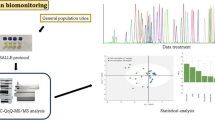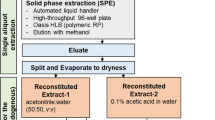Abstract
Heterocyclic amines (HCAs) formed in cooked meats and fish are mutagens and carcinogens in rodents and nonprimates. Exposure to HCAs may also be a risk factor for human tumors, but the association between dietary intake and human cancer risk has not been determined. To assess recent exposure to HCAs, we developed a simple and sensitive method for measuring HCAs in urine by automated on-line in-tube solid-phase microextraction (SPME) using a Supel-Q PLOT capillary column as an extraction device, in combination with liquid chromatography–tandem mass spectrometry (LC–MS/MS). Thirteen HCAs were separated within 15 min using a ZORBAX Eclipse XDB-C8 column and detected selectively by multiple reaction monitoring using MS/MS. This method can be applied easily to the analysis of small amounts of urine samples without any other pretreatment except for alkaline hydrolysis of bound forms of HCAs. The quantification limits of HCAs in 0.2 mL of urine samples were about 1.7–4.1 pg/mL (S/N = 10). Using this method, we evaluated the exposure to HCAs in persons who consumed well-done pan-fried beef and the suitability of using urinary HCAs as exposure biomarkers. We also analyzed the ability of vegetable consumption to prevent carcinogenic risks from exposure to HCAs by measuring free and bound forms of HCAs in urine.

Mutagenic and carcinogenic heterocyclic amines are ingested from cooked foods and cigarette smoke, formed metabolites and adducts in target tissue, and excreted in urine and feces




Similar content being viewed by others
References
Sugimura T, Wakabayashi K, Nakagama H, Nagao M (2004) Heterocyclic amines: mutagens/carcinogens produced during cooking of meat and fish. Cancer Sci 95:290–299
Knize MG, Felton JS (2005) Formation and human risk of carcinogenic heterocyclic amines formed from natural precursors in meat. Nutr Rev 63:158–165
Turesky RJ (2007) Formation and biochemistry of carcinogenic heterocyclic aromatic amines in cooked meats. Toxicol Lett 168:219–227
Alaejos MS, González V, Afonso AM (2008) Exposure to heterocyclic aromatic amines from the consumption of cooked red meat and its effect on human cancer risk: a review. Food Addit Contam Part A: Chem Anal Control Expo Risk Assess 25:2–24
Felton JS, Knize MG, Wu RW, Colvin ME, Hatch FT, Malfatti MA (2007) Mutagenic potency of food-derived heterocyclic amines. Mutat Res 616:90–94
Cheng KW, Chen F, Wang M (2006) Heterocyclic amines: chemistry and health. Mol Nutr Food Res 50:1150–1170
Murkovic M (2004) Formation of heterocyclic aromatic amines in model systems. J Chromatogr B Anal Technol Biomed Life Sci 802:3–10
Alaejos MS, Ayala JH, González V, Afonso AM (2008) Analytical methods applied to the determination of heterocyclic aromatic amines in foods. J Chromatogr B Anal Technol Biomed Life Sci 862:15–42
Sinha R (2002) An epidemiologic approach to studying heterocyclic amines. Mutat Res 506–507:197–204
Felton JS, Knize MG, Salmon CP, Malfatti MA, Kulp KS (2002) Human exposure to heterocyclic amine food mutagens/carcinogens: relevance to breast cancer. Environ Mol Mutagen 39:112–118
Tasevska N, Sinha R, Kipnis V, Subar AF, Leitzmann MF, Hollenbeck AR, Caporaso NE, Schatzkin A, Cross AJ (2009) A prospective study of meat, cooking methods, meat mutagens, heme iron, and lung cancer risks. Am J Clin Nutr 89:1884–1894
Turesky RJ, Le Marchand L (2011) Metabolism and biomarkers of heterocyclic aromatic amines in molecular epidemiology studies: lessons learned from aromatic amines. Chem Res Toxicol 24:1169–1214
Alexander J, Reistad R, Hegstad S, Frandsen H, Ingebrigtsen K, Paulsen JE, Becher G (2002) Biomarkers of exposure to heterocyclic amines: approaches to improve the exposure assessment. Food Chem Toxicol 40:1131–1137
Murray S, Lake BG, Gray S, Edwards AJ, Springall C, Bowey EA, Williamson G, Boobis AR, Gooderham NJ (2001) Effect of cruciferous vegetable consumption on heterocyclic aromatic amine metabolism in man. Carcinogenesis 22:1413–1420
Kapiszewska M (2006) A vegetable to meat consumption ratio as a relevant factor determining cancer preventive diet. The Mediterranean versus other European countries. Forum Nutr 59:130–153
Platt KL, Edenharder R, Aderhold S, Muckel E, Glatt H (2010) Fruits and vegetables protect against the genotoxicity of heterocyclic aromatic amines activated by human xenobiotic-metabolizing enzymes expressed in immortal mammalian cells. Mutat Res 703:90–98
Abdull Razis AF, Noor NM (2013) Cruciferous vegetables: dietary phytochemicals for cancer prevention. Asian Pac J Cancer Prev 14:1565–1570
Appenzeller BM, Tsatsakis AM (2012) Hair analysis for biomonitoring of environmental and occupational exposure to organic pollutants: state of the art, critical review and future needs. Toxicol Lett 210:119–140
Kataoka H, Inoue T, Saito K, Kato H, Masuda K (2013) Analysis of heterocyclic amines in hair by on-line in-tube solid-phase microextraction coupled with liquid chromatography-tandem mass spectrometry. Anal Chim Acta 786:54–60
Strickland PT, Oian Z, Friesen MD, Rothman N, Sinha R (2002) Metabolites of 2-amino-1-methyl-6-phenylimidazo(4,5-b)pyridine (PhIP) in human urine after consumption of charbroiled or fried beef. Mutat Res 506–507:163–173
Shah FU, Barri T, Jönsson JA, Skog K (2004) Determination of heterocyclic aromatic amines in human urine by using hollow-fibre supported liquid membrane extraction and liquid chromatography-ultraviolet detection system. J Chromatogr B Anal Technol Biomed Life Sci 870:203–208
Lezamiz J, Barri T, Jönsson JA, Skog K (2008) A simplified hollow-fibre supported liquid membrane extraction method for quantification of 2-amino-1-methyl-6-phenylimidazo[4,5-b]pyridine (PhIP) in urine and plasma samples. Anal Bioanal Chem 390:689–696
De Andrés F, Zougagh M, Castañeda G, Sánchez-Rojas JL, Ríos A (2011) Screening of non-polar heterocyclic amines in urine by microextraction in packed sorbent-fluorimetric detection and confirmation by capillary liquid chromatography. Talanta 83:1562–1567
De Andrés F, Zougagh M, Castañeda G, Ríos A (2010) Determination of heterocyclic amines in urine samples by capillary liquid chromatography with evaporated light-scattering detection. Anal Bioanal Chem 397:223–231
Holland RD, Taylor J, Schoenbachler L, Jones RC, Freeman JP, Miller DW, Lake BG, Gooderham NJ, Turesky RJ (2004) Rapid biomonitoring of heterocyclic aromatic amines in human urine by tandem solvent solid phase extraction liquid chromatography electrospray ionization mass spectrometry. Chem Res Toxicol 17:1121–1136
Holland RD, Gehring T, Taylor J, Lake BG, Gooderham NJ, Turesky RJ (2005) Formation of a mutagenic heterocyclic aromatic amine from creatinine in urine of meat eaters and vegetarians. Chem Res Toxicol 18:579–590
Frandsen H (2008) Biomonitoring of urinary metabolites of 2-amino-1-methyl-6-phenylimidazo[4,5-b]pyridine (PhIP) following human consumption of cooked chicken. Food Chem Toxicol 46:3200–3205
Busquets R, Jönsson JA, Frandsen H, Puignou L, Galceran MT, Skog K (2009) Hollow fibre-supported liquid membrane extraction and LC-MS/MS detection for the analysis of heterocyclic amines in urine samples. Mol Nutr Food Res 53:1496–1504
Fede J-M, Thakur AP, Gooderham NJ, Turesky RJ (2009) Biomonitoring of 2-amino-1-methyl-6-phenylimidazo[4,5-b]pyridine (PhIP) and its carcinogenic metabolites in urine. Chem Res Toxicol 22:1096–1105
Gu D, Raymundo MM, Kadlubar FF, Turesky RJ (2011) Ultraperformance liquid chromatography-tandem mass spectrometry method for biomonitoring cooked meat carcinogens and their metabolites in human urine. Anal Chem 83:1093–1101
Busquets R, Frandsen H, Jönsson JÅ, Puignou L, Galceran MT, Skog K (2013) Biomonitoring of dietary heterocyclic amines and metabolites in urine by liquid phase microextraction: 2-amino-1-methyl-6-phenylimidazo[4,5-b]pyridine (PhIP), a possible biomarker of exposure to dietary PhIP. Chem Res Toxicol 26:233–240
Viberg P, Wahlund KG, Skog K (2006) On-line capillary based quantitative analysis of a heterocyclic amine in human urine. J Chromatogr A 1133:347–352
Sentellas S, Moyano E, Puignou L, Galceran MT (2004) Optimization of a clean-up procedure for the determination of heterocyclic aromatic amines in urine by field-amplified sample injection-capillary electrophoresis-mass spectrometry. J Chromatogr A 1032:193–201
Kataoka H, Saito K (2012) Recent advances in column switching sample preparation in bioanalysis. Bioanalysis 4:809–832
Kataoka H, Lord HL, Pawliszyn J (2000) Simple and rapid determination of amphetamine, methamphetamine, and their methylenedioxy derivatives in urine by automated in-tube solid-phase microextraction coupled with liquid chromatography-electrospray ionization mass spectrometry. J Anal Toxicol 24:257–265
Kataoka H, Inoue R, Yagi K, Saito K (2009) Determination of nicotine, cotinine, and related alkaloids in human urine and saliva by automated in-tube solid-phase microextraction coupled with liquid chromatography-mass spectrometry. J Pharm Biomed Anal 49:108–114
Saito K, Yagi K, Ishizaki A, Kataoka H (2010) Determination of anabolic steroids in human urine by automated in-tube solid-phase microextraction coupled with liquid chromatography-mass spectrometry. J Pharm Biomed Anal 52:727–733
Kataoka H (2002) Automated sample preparation using in-tube solid-phase microextraction and its application—a review. Anal Bioanal Chem 373:31–45
Kataoka H, Ishizaki A, Nonaka Y, Saito K (2009) Developments and applications of capillary microextraction techniques: a review. Anal Chim Acta 655:8–29
Kataoka H (2010) Recent developments and applications of microextraction techniques in drug analysis. Anal Bioanal Chem 396:339–364
Kataoka H, Saito K (2011) Recent advances in SPME techniques in biomedical analysis. J Pharm Biomed Anal 54:926–950
Acknowledgments
This work was supported by the National Cancer Center Research and Development Fund and the Science Research Promotion Fund, a Grant-in-Aid for Basic Scientific Research (C no. 22590048).
Author information
Authors and Affiliations
Corresponding author
Additional information
Published in the topical collection Microextraction Techniques with guest editors Miguel Valcárcel Cases, Soledad Cárdenas Aranzana and Rafael Lucena Rodríguez.
Electronic Supplementary Material
Below is the link to the electronic supplementary material.
ESM 1
(PDF 1114 kb)
Rights and permissions
About this article
Cite this article
Kataoka, H., Inoue, T., Ikekita, N. et al. Development of exposure assessment method based on the analysis of urinary heterocyclic amines as biomarkers by on-line in-tube solid-phase microextraction coupled with liquid chromatography–tandem mass spectrometry. Anal Bioanal Chem 406, 2171–2178 (2014). https://doi.org/10.1007/s00216-013-7420-1
Received:
Revised:
Accepted:
Published:
Issue Date:
DOI: https://doi.org/10.1007/s00216-013-7420-1




